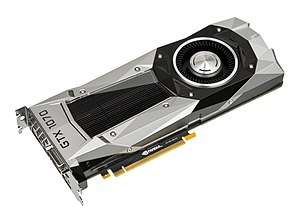 A GTX 1070 Founders Edition graphics based on the Pascal architecture | |
| Launched | May 27, 2016 |
|---|---|
| Designed by | Nvidia |
| Manufactured by | |
| Fabrication process | |
| Codename(s) | GP10x |
| Product Series | |
| Desktop | |
| Professional/workstation | |
| Server/datacenter | |
| Specifications | |
| L1 cache | 24 KB (per SM) |
| L2 cache | 256 KB—4 MB |
| Memory support | |
| PCIe support | PCIe 3.0 |
| Supported Graphics APIs | |
| DirectX | DirectX 12 (12.1) |
| Direct3D | Direct3D 12.0 |
| Shader Model | Shader Model 6.7 |
| OpenCL | OpenCL 3.0 |
| OpenGL | OpenGL 4.6 |
| CUDA | Compute Capability 6.0 |
| Vulkan | Vulkan 1.3 |
| Media Engine | |
| Encode codecs | |
| Decode codecs | |
| Color bit-depth |
|
| Encoder(s) supported | NVENC |
| Display outputs | |
| History | |
| Predecessor | Maxwell |
| Successor | |

Pascal is the codename for a GPU microarchitecture developed by Nvidia, as the successor to the Maxwell architecture. The architecture was first introduced in April 2016 with the release of the Tesla P100 (GP100) on April 5, 2016, and is primarily used in the GeForce 10 series, starting with the GeForce GTX 1080 and GTX 1070 (both using the GP104 GPU), which were released on May 27, 2016, and June 10, 2016, respectively. Pascal was manufactured using TSMC's 16 nm FinFET process,[1] and later Samsung's 14 nm FinFET process.[2]
The architecture is named after the 17th century French mathematician and physicist, Blaise Pascal.
In April 2019, Nvidia enabled a software implementation of DirectX Raytracing on Pascal-based cards starting with the GTX 1060 6 GB, and in the 16 series cards, a feature reserved to the Turing-based RTX series up to that point.[3][4]
- ^ "NVIDIA 7nm Next-Gen-GPUs To Be Built By TSMC". Wccftech. June 24, 2018. Retrieved July 6, 2019.
- ^ "Samsung to Optical-Shrink NVIDIA "Pascal" to 14 nm". Retrieved August 13, 2016.
- ^ "Accelerating The Real-Time Ray Tracing Ecosystem: DXR For GeForce RTX and GeForce GTX". NVIDIA.
- ^ "Ray Tracing Comes to Nvidia GTX GPUs: Here's How to Enable It". April 11, 2019.